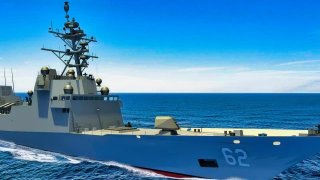The Navy's Constellation-Class Frigate Drama Won't Ever End
The U.S. Navy's plan to modernize its fleet with 20 new Constellation-class frigates is facing significant delays and challenges. Aimed at maintaining a qualitative edge over China's growing naval power, these multi-mission warships are designed for air, surface, anti-submarine, and electromagnetic warfare, especially in littoral waters.
What You Need to Know: The U.S. Navy's plan to modernize its fleet with 20 new Constellation-class frigates is facing significant delays and challenges. Aimed at maintaining a qualitative edge over China's growing naval power, these multi-mission warships are designed for air, surface, anti-submarine, and electromagnetic warfare, especially in littoral waters.
-However, construction on the lead ship, the future USS Constellation, began in 2022 but is now delayed until 2029—three years behind schedule.
-A Government Accountability Office (GAO) report indicates the program is at a standstill, citing weight issues and a lack of finalized design. These setbacks could affect the ships' speed, operational capabilities, and lifespan, raising concerns about the Navy's efforts to modernize effectively.
U.S. Navy's Constellation-Class Frigates Face Delays and Challenges
The U.S. Navy has lost its numerical superiority to China and is looking to retain its qualitative edge. One way the Navy is trying to ensure that it has the best possible warships on the seas is through modernizing old vessels and adding new ones.
The Constellation-class frigate is part of that effort. However, the guided missile ship program has been presenting challenges and delays to the Navy.
The Constellation Frigate and Its Challenges
The Navy is modernizing its fleet to meet the challenges of tomorrow. As part of this effort, the Navy has planned the purchase of twenty Constellation-class frigates.
A multi-mission warship, the Constellation-class frigate will be able to conduct air warfare, anti-submarine warfare, surface warfare, and electromagnetic maneuver warfare. Its weight and size will enable the warship to operate in littoral waters and better support conventional and special operations forces.
The warship will pack an Enterprise Air Surveillance Radar (EASR), Baseline Ten (BL10) Aegis Combat System, a Mk-41 Vertical Launch System capable of firing dozens of Tomahawk cruise missiles, Naval Strike Missiles, and anti-air munitions.
However, the program has been facing some strong headwinds.
Work on the lead ship of the class, the future USS Constellation, began in 2022, but the warship won’t be ready until 2029, or with a three-year delay, according to the Navy.
In its latest report on the Constellation-class frigate, the Government Accountability Office (GAO) estimated that the program is at a standstill. The GAO report also added that it could take more than seven years between the beginning of construction of a Constellation frigate and its delivery to the Navy. Once the Navy receives a new warship, it puts it through rigorous testing and sea trials before it gives it the green light to join the active fleet as an operational vessel. So, it takes as long as a decade before a Constellation-class frigate is operational under the current timeline.
Another issue that the Constellation program is facing has to do with its weight and expected lifespan. The Navy gave the green light to begin construction without a final design. As a result, there are unforeseen weight issues with the ship that could affect its speed, and thus hurt operational capabilities, and its ability to add new systems and technologies down the line, thus limiting its lifespan.
With the Constellation-class, the Navy returns to the frigate after almost a decade. The last frigates in the Navy were the Oliver Hazard Perry-class, which retired in 2015. The Navy planned to use the Littoral Combat Ship as a substitute, but that program failed to produce the intended results and the Navy is in the process of retiring all of the classes’ ships.
Frigates are easier to manufacture and require a smaller crew than destroyers and cruisers. They are smaller and lighter and can thus operate more easily in littoral waters. However, they can carry fewer weapon systems than larger warships and could be outfired in a naval engagement.
About the Author:
Stavros Atlamazoglou is a seasoned defense journalist specializing in special operations and a Hellenic Army veteran (national service with the 575th Marine Battalion and Army HQ). He holds a BA from the Johns Hopkins University and an MA from the Johns Hopkins’ School of Advanced International Studies (SAIS). His work has been featured in Business Insider, Sandboxx, and SOFREP.
Image Credit: Creative Commons and/or Shutterstock.


